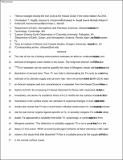Thorium isotopes tracing the iron cycle at the Hawaii Ocean Time-series Station ALOHA
Author(s)
Anderson, Robert F.; Weisend, Rachel; Morton, Peter L.; Hayes, Christopher Tyler; Fitzsimmons, Jessica Nicole; Boyle, Edward A; McGee, William David; ... Show more Show less
DownloadBoyle 4 GCA-S-14-01062-1.pdf (537.2Kb)
PUBLISHER_CC
Publisher with Creative Commons License
Creative Commons Attribution
Terms of use
Metadata
Show full item recordAbstract
The role of iron as a limiting micronutrient motivates an effort to understand the supply and removal of lithogenic trace metals in the ocean. The long-lived thorium isotopes (²³²Th and ²³⁰Th) in seawater can be used to quantify the input of lithogenic metals attributable to the partial dissolution of aerosol dust. Thus, Th can help in disentangling the Fe cycle by providing an estimate of its ultimate supply and turnover rate. Here we present time-series (1994–2014) data on thorium isotopes and iron concentrations in seawater from the Hawaii Ocean Time-series Station ALOHA. By comparing Th-based dissolved Fe fluxes with measured dissolved Fe inventories, we derive Fe residence times of 6–12 months for the surface ocean. Therefore, Fe inventories in the surface ocean are sensitive to seasonal changes in dust input. Ultrafiltration results further reveal that Th has a much lower colloidal content than Fe does, despite a common source. On this basis, we suggest Fe colloids may be predominantly organic in composition, at least at Station ALOHA. In the deep ocean (>2 km), Fe approaches a solubility limit while Th, surprisingly, is continually leached from lithogenic particles. This distinction has implications for the relevance of Fe ligand availability in the deep ocean, but also suggests Th is not a good tracer for Fe in deep waters. While uncovering divergent behavior of these elements in the water column, this study finds that dissolved Th flux is a suitable proxy for the supply of Fe from dust in the remote surface ocean.
Date issued
2015-07Department
Massachusetts Institute of Technology. Department of Earth, Atmospheric, and Planetary SciencesJournal
Geochimica et Cosmochimica Acta
Publisher
Elsevier
Citation
Hayes, Christopher T. et al. “Thorium Isotopes Tracing the Iron Cycle at the Hawaii Ocean Time-Series Station ALOHA.” Geochimica et Cosmochimica Acta 169 (November 2015): 1–16 © 2015 Elsevier Ltd
Version: Author's final manuscript
ISSN
0016-7037